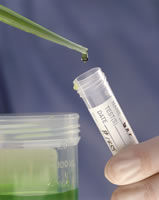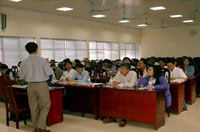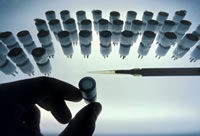Pocket K No. 9: Intellectual Property Rights and Agricultural Biotechnology
| |
Introduction
One of the main features of modern agricultural biotechnology (agri-biotech) is its increasing proprietary nature. Unlike the agricultural sciences of the past, which came out of publicly funded labs, new biotechnologies are protected by patents and other intellectual property rights (IPRs). Will these IPRs, which are predominantly owned by the private sector, lead to the monopolization of seeds, research tools, and even knowledge? Will they promote research and development by providing incentive for investment and encourage access to inventions produced elsewhere?
The ownership of IPRs in agri-biotech is now an issue in the development of products and the transfer of the technology to developing countries. Scientists now need to consider IPRs as an important factor in their research, especially where the aim is product development. Since the early 1990s, most major research organizations, whether public or private, are actively considering and/or implementing IPR policies.
What is Intellectual Property?
|
Intellectual property represents products of the mind or intellect. They are ideas that, when converted to tangible forms, can be protected. Examples of intellectual properties include inventions, computer software, publications, videotapes, music, and plant varieties.
Developing such products usually requires a great deal of time and financial investment. Therefore, the inventor usually seeks a return on his effort by acquiring IPRs. They allow the inventor to restrict the use of the intellectual property, i.e., no one is allowed to use, manufacture, grow, sell or offer to sell the invention without permission. Several forms of this protection exist and they include copyright, trade secret, trademarks, plant breeder's rights, and patents.
What are the functions of IPR?
IPRs are intended to promote research and development by providing incentives for investment in the creative process and encourage access to inventions produced elsewhere.
IPRs and Developing Countries
Patents, plant breeder's rights and trademarks are awarded by national governments, and the protection is valid only in countries in which they are issued. Thus, to obtain protection in several countries, rights must be applied for and awarded in each. On the other hand, copyright and trade secrets are not country specific.
At present, many key technologies used in the development of agri-biotech products appear to be unprotected in developing countries. For example, patents for the most widely used promoter, the CaMV 35S promoter, have been granted only in the United States and Europe (and the only pending application is in Japan) (Binenbaum et al., 2000). Thus, there are no IP restrictions in developing countries on the use of this tool in research and development at present.
Furthermore, anyone is free to use technologies in crops that are developed, produced, and consumed in countries where the technology is not subject to local IP protection. IP problems, however, may arise when these crops are subsequently exported to countries in which the technologies are protected by IPRs. The development time should also be taken into consideration since patents might be issued in the country by the time the product is developed. It is therefore necessary for scientists in developing countries to be aware of the IP issues and develop strategic plans in handling these IP concerns.
Promoting transfer of agri-biotech to developing countries
|
Crops grown for subsistence use in developing countries and the technologies that are used to develop such crops are clearly of little commercial interest to the private sector. Thus, donating proprietary technologies to develop such crops is a realistic possibility, and in fact is already happening. However, developing country scientists must remember that technology transfer involves a lot more than simply signing a license or a material transfer agreement for a product. Both technology donor and recipient must be aware of the IPR issues involved in the technology and there will often be a need for partnerships in which there is mutual trust among all parties (Kratigger, 2002).
Developing countries frequently lack the required IP management capacity and resources to perform product clearance analyses and evaluations that facilitate the legitimate import, use and/or export of technologically advanced products (Kowalski, et al., 2002). Thus, to help transfer of appropriate agri-biotech to developing countries, capacity building in IPR management is of vital importance from both the donor and the recipient side. This can involve the following:
- Educate research staff and research administrators on the basic principles of IPR management.
- Use different patent databases as well as scientific databases as information sources.
- Remain aware of the complexity of germplasm issues.
- Stress the importance of good laboratory records.
- Document what comes in and goes out of the lab.
- Establish clear lines of responsibility for negotiating, reviewing and signing Material Transfer Agreements (MTAs) and licenses.
- Manage and organize licenses and MTAs and the various documents and correspondence associated with them.
How do you protect your rights?
The main ways to protect your intellectual property rights include copyrights, trade secret, trademarks, plant breeders' rights, and patents (Binenbaum et al., 2000). Of the five, the last two are the most relevant forms of IP protection in plant breeding.
Plant Breeder's Rights
|
Plant breeder's rights (PBRs) are used to protect new varieties of plants by giving exclusive commercial rights for about 20 -25 years to market a new variety or its reproductive material. The variety must be novel, distinct, uniform, and stable. This protection prevents anyone from growing or selling the variety without the owner's permission. Exceptions may be made, however, for both research and use of seed saved by a farmer for replanting.
Patent
A patent is an exclusive right given to an inventor to exclude all others from making, using, selling or offering to sell the invention in the country that granted the patent right, and importing it into that country. In agricultural biotechnology, patents may cover, for example, plant transformation methods, vectors, genes, etc. and in countries that allow patenting of higher life forms, transgenic plants or animals.
Patents are the most critical form of protection for agricultural biotechnology and considered to be the most powerful in the IP system. Patents are temporary, generally about 20 years, and are country specific (Binenbaum et al., 2000).
Conclusion
Publicly funded research institutions should build up their capacity to manage intellectual properties that they procure and those that they generate. Knowledge of IPRs will help developing country scientists determine if information about a particular technology is already part of the public domain and therefore freely available. Moreover, IPs generated by the public sector can be considered assets that can be exchanged for private sector-owned IPs or used as bargaining chips in technology transfer negotiations. Partnership between the private and public sectors in technology development through sharing of knowhow and IP can hasten technology transfer and acquisition on both sides.
| |
Suggested Readings
- ADB 2001. Agricultural biotechnology, poverty reduction, and food security. A working paper. http://www.adb.org
- Binenbaum, E., Nottenburg, C., Pardey, P.G., Wright, B.D., and Zambrano, P. 2000. South-North Trade, Intellectual Property Jurisdictions, and Freedom to Operate in Agricultural Research on Staple Crops. International Food Policy Research Institute, Washington D.C.
- Cohen, JI and Paarlberg, R. 2002. Explaining restricted approval and availability of GM crops in developing countries. Agbiotechnet 2002. Vol 4 October. http://www.agbiotechnet.com
- Kowalski, S.P., Ebora, R.V., Kryder, R.D, and Potter, R.H. 2002. "Transgenic crops, biotechnology and ownership rights: What scientists need to know." The Plant Journal 31(4): 407-421
- Krattiger, A.F. 2002. "Public-private partnerships for efficient proprietary biotech management and transfer, and increased private sector investments. A briefings paper with six proposals commissioned by UNIDO." IP Strategy Today No. 4-2002
- NOLO: Law for All http://www.nolo.com
- Pardey, PG, Wright, BD, and Nottenburg, C. 2001. International Food Policy Research Institute 2000-2001 Annual Report. http://www.ifpri.org
- United States Patent and Trademark Office http://www.uspto.gov
- World Intellectual Property Organization http://www.wipo.org
*Updated July 2004
Next Pocket K: Herbicide Tolerance Technology Glyphosate and Glufosinate
-
Foldable Version (PDF)
- English
-
Document Version (PDF)
- English
- Vietnamese



